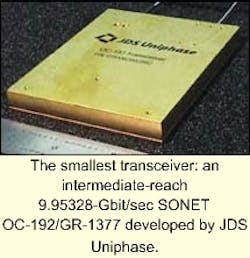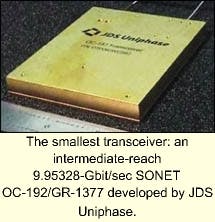Outsourcing requirements
Outsourcing subsystems is an emerging trend
Today, systems vendors want more than just components from suppliers, freeing up scarce engineering resources to core competencies.
Aaron Hollander, Vinnie Rodino, Ed Teague, and Gerald Curtin, JDS Uniphase
A move toward outsourcing is helping systems vendors focus on their competitive strengths. These companies purchase optical and optoelectronic subsystems rather than single components, which allows them to redirect resources to core competencies and reduce the time-to-market of products.
The traditional approach of purchasing components one by one from a range of suppliers and assembling them into optical-core subsystems forces vendors to dedicate resources to integration, packaging, and assembly with relatively low value added. Outsourcing these functions instead involves interacting with suppliers capable of providing design services and modules integrated to meet specified application requirements.
Key advantages of the outsourcing approach include a reduction in engineering manpower requirements and the opportunity to have module and subsystem integration performed by a supplier whose core competency encompasses optical integration and assembly. In addition, outsourcing promotes higher levels of integration that in turn can provide smaller package sizes, higher speeds, and reduced production costs.
As the proliferation of DSL, cable, and local optical networks begins to ease bottlenecks in the access portion of the network, the strain on metropolitan and backbone networks is increasing at a rapid rate. The transmission core of today's long-haul optical networks is dominated by DWDM technologies that deliver high bit rates over multiple data channels. The current state of the art provides 80 channels at 10 Gbits/sec. Meanwhile the market is moving toward a new generation of core systems capable of delivering 160 channels at 40 Gbits/sec each.
The speed of optical-crossconnect switches must be substantially upgraded in order to manage ever-growing core traffic. A new generation of optical edge switches is needed to peel off higher volumes of network traffic from the core to meet increasing demand from local data sources. Finally, with fiber deployed in most metropolitan areas, there's an increasing need for new transmission equipment to deliver DWDM, Gigabit Ethernet, and Fibre Channel directly to the end user.
Some of today's leaders in providing the high-speed transmission and switching equipment needed for the next-generation optical core include Cisco Systems, Nortel Networks, Alcatel, Lucent Technologies, Juniper Networks, Sycamore Networks, Ciena, Corvis, and Redback Systems. In addition, a larger number of up-and-coming companies are developing interesting technologies in this space. These systems vendors face the challenge of developing the optical systems needed to drive enormous increases in traffic through the core in a fast-changing and extremely competitive market. This challenge involves not only working with the latest optical technologies, but also integrating the electronics required to add intelligence by performing tasks such as routing, packet switching, and network management. The magnitude of the technical challenge, the breadth of the expertise required, and the extremely short product cycles involved help to explain why many of today's systems vendors are stretched thin from an engineering standpoint.
The traditional approach of building systems through the integration and purchase of individual optical and electronic components is not well suited to meet this challenge. Engineers have to take the time to specify all of the parameters of each individual component; develop an integrated design; source each of the individual components; develop electronic, mechanical, and optical assembly; test and rework processes; and manage supply-chain logistics for each individual component. The range of technologies involved means that engineers and manufacturing personnel are often working outside their comfort zone, which can sometimes lead to less-than-optimal designs and higher-than-necessary manufacturing costs. The sheer volume of components involved in today's high-end optical systems combined with the short product cycles required to stay competitive in providing equipment for the optical core presents an enormous challenge that stresses every corner of an optical-system vendor's organization.
So it should come as no surprise that the concept of outsourcing design and manufacture of modules and subsystems is beginning to pick up momentum. The basic idea is that the outsourcing supplier delivers complete building blocks, build-to-print modules, custom-designed modules, or even complete subsystems that integrate both optical and electronic functionality such as amplifiers or transponder modules. The key advantage, from the standpoint of the systems vendor, is that engineering, integration, assembly, and logistics issues are suddenly reduced to a fraction of their current magnitude. Rather than specifying and integrating each individual component, engineers only have to determine the necessary optical and electronic parameters of the system. The outsourcing supplier takes over complete responsibility for meeting these requirements while managing the entire value stream, including module design, assembly, testing, material procurement, inventory, and logistics. The systems vendor needs to manage only one part number for the module, or subsystem, as opposed to the hundreds that must be dealt with using the traditional method.Another advantage of outsourcing is that it opens the door to achieving higher levels of integration, especially in merging optics and electronics. By interaction with the systems vendor at a higher level, components suppliers can develop a better understanding of customer requirements. The result can provide component suppliers with a good road map to follow regarding the integration of multiple functions at the component level. This trend has emerged in the last several years as optical vendors purchased driver companies and began developing optoelectronic modules. One of its earlier manifestations was combining source lasers, pump lasers, and modulators with the electronic drivers that are needed to make them work.
In the future, optical components will begin to integrate with electronics at the conversion points where optical signals are converted to electronics signals and back again, such as routers and switches. One of the first fruits of this effort is the emergence of optical-trans ponder modules that merge transmitters, receivers, and physical-layer chipsets that typically perform clock and data recovery, multiplexing/ demultiplexing, and clock multiplication operations.
On the other hand, outsourcing increases the demands on suppliers. Component suppliers must more closely understand the system vendor's application requirements, meet greater engineering challenges, and develop module-level design, integration, and manufacturing capabilities. Successful outsourcers are usually suppliers that already provide a wide range of components, enabling them to develop the broad expertise in the different disciplines required to create optoelectronic modules. Providing subsystems that include electronics functionality such as driver circuitry requires skills that smaller optical suppliers often do not possess. For example, a supplier of transponder modules must deal with issues such as multiplexing a 16-line data interface to avoid the extra cost that would be involved in dealing with the higher data rate required for a single line interface.
An example of the type of modules becoming available from optoelectronic suppliers includes small-form-factor transponder modules designed to provide the required electrical and optical interfaces between the SONET/SDH photonic physical layer and the electrical section layer of the network. One typical implementation provides a 10-Gbit/sec optical transmitter and a 10-Gbit/sec optical receiver in the same physical package with clock synthesis and clock recovery circuits. These low-power modules have integrated multiplexing and demultiplexing capability and are available with optical-signal coding for enhanced signal detection. They measure only 3.5x4.5x0.53 inches, demonstrating the size reductions that can be achieved through optoelectronic integration. The modules also meet multiple-source-agreement (MSA) specifications for small-footprint OC-192 SONET/SDH transponders. Under the MSA, a full drop-in solution is specified, enabling customers to benefit from multiple sources. The new MSA specifies a 200-pin connector and pinout that provides customers with an electrical interface compliant with Optical Internet working Forum specifications.
Another illustration of the benefits of outsourcing is provided by new intermediate-reach 9.95328-Gbit/sec SONET OC-192/GR-1377 transceivers that offer a higher level of integration and a smaller-than-ever-before form factor, making these devices ideal for quick-to-market design strategies (see Photo). This new generation of transceivers includes an integrated electrical multiplexer and demultiplexer to perform parallel-electrical-to-serial-optical-signal conversion and serial-optical-to-parallel-electrical conversion. These transceivers are designed for fiber distances between 12 and 50 km and comply with the 300-pin MSA. The electrical interface consists of 16 differential lines of data at 622.08 Mbits/sec in both the transmit and receive directions. The optical interface is a 9.95328-Gbit/sec optical transport that can transmit and receive up to 50 km of singlemode fiber.
All in all, the outsourcing approach combined with the higher levels of integration that it promotes provides one-stop shopping for optical subsystems, drastically reducing the level of engineering resources required to design and build leading-edge optical-core equipment. Systems vendors avoid the problems involved with integrating and assembling hundreds of different parts, including the associated material management and logistics. Outsourcing reduces the workload down to selecting a single part number that has been validated to work together as an optical or optoelectronic subsystem. The net result is a simpler, faster, less expensive way to access fiber-optic component technologies, allowing systems vendors to focus scarce resources on the systems design and development activities that distinguish their products in a highly competitive marketplace.
Aaron Hollander is a marketing manager, Vinnie Rodino is a manager for advanced digital and RF products, and Ed Teague is vice president of marketing and business strategy for the Transmission Group at JDS Uniphase (Bloomfield, CT). Gerald Curtin is a product manager at JDS's design center (San Jose, CA).

